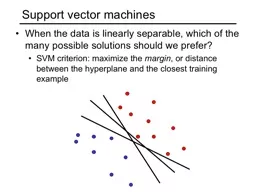

SVM criterion maximize the margin or distance between the hyperplane and the closest training example Support vector machines When the data is linearly separable which of the many possible solutions should we prefer ID: 688892
Download Presentation The PPT/PDF document "Support vector machines When the data is..." is the property of its rightful owner. Permission is granted to download and print the materials on this web site for personal, non-commercial use only, and to display it on your personal computer provided you do not modify the materials and that you retain all copyright notices contained in the materials. By downloading content from our website, you accept the terms of this agreement.
Slide1
Support vector machines
When the data is linearly separable, which of the many possible solutions should we prefer?SVM criterion: maximize the margin, or distance between the hyperplane and the closest training exampleSlide2
Support vector machines
When the data is linearly separable, which of the many possible solutions should we prefer?
SVM criterion: maximize the
margin, or distance between the hyperplane and the closest training example
Margin
Support vectorsSlide3
Finding the maximum margin hyperplane
Define the
margin as the distance between the hyperplane
and the closest point
Distance between point and hyperplane is given by
Assuming the data is linearly separable, we can fix the scale of
and
so that
and
for all other points
Then the margin is
Slide4
Finding the maximum margin hyperplane
Find separating hyperplane that maximizes the distance to the closest training example
Margin
Support vectors
Positive examples:
Negative examples:
For support vectors,
The margin is
Slide5
Finding the maximum margin hyperplane
Maximize margin
while correctly classifying all training data:
positive:
negative:
Equivalent problem:
This is a quadratic objective with linear constraints: convex optimization, global optimum can be found using well-studied methods
Slide6
“Soft margin” formulation
What about non-separable data?
And even for separable data, we may prefer a larger margin with a few constraints violated
SourceSlide7
“Soft margin” formulation
What about non-separable data?
And even for separable data, we may prefer a larger margin with a few constraints violated
SourceSlide8
“Soft margin” formulation
+1
-1
0
Penalize margin violations using
hinge loss
:
Incorrectly classified
Correctly classified
Hinge lossSlide9
“Soft margin” formulation
+1
-1
0
Penalize margin violations using
hinge loss
:
Incorrectly classified
Correctly classified
Hinge loss
Recall hinge loss used by the perceptron update algorithm!Slide10
Penalize margin violations using
hinge loss:
“Soft margin” formulation
Maximize margin –
a.k.a.
regularization
Minimize misclassification lossSlide11
SGD optimization (omitting bias)
Recall:
Slide12
SGD optimization (omitting bias)
SGD update:
If
:
Otherwise:
S. Shalev-Schwartz et al.,
Pegasos: Primal Estimated sub-
GrAdient
SOlver
for SVM
,
Mathematical Programming
, 2011Slide13
SVM vs. perceptron
SVM loss:
SVM update:
If
:
Otherwise:
Perceptron loss:
Perceptron update:
If
:
Otherwise: do nothing
What are the differences?
Slide14
Dual SVM formulation
SVM objective:
Directly solving for
using SGD is called the
primal
approach
Instead, SVM optimization can be formulated to learn a classifier in the form
by solving a
dual
optimization problem over
Slide15
Dual SVM formulation
The dual problem (given without derivation):
Important properties of the dual:
At the optimum,
are nonzero only for support vectors
Feature vectors appear only inside dot products
:
this enables nonlinear SVMs via
kernel functions
Slide16
Φ
:
x
→
φ
(
x
)
Nonlinear SVMs
General idea: the original input space can always be mapped to some higher-dimensional feature space where the training set is separable
Slide credit: Andrew MooreSlide17
Nonlinear SVMs
The kernel trick: instead of explicitly computing the lifting transformation
,
define a kernel function
To be valid, the kernel function must satisfy
Mercer’s condition
This gives a nonlinear decision boundary in the original feature space:
Slide18
Non-separable data in 1D:
Apply mapping
:
0
x
0
x
x
2
ExampleSlide19
Kernel example 1: Polynomial
Polynomial kernel with degree and constant
:
What this looks like for
:
Thus, the explicit feature transformation consists of all polynomial combinations of individual dimensions of degree up to
Slide20
Kernel example 1: PolynomialSlide21
Kernel example 2: Gaussian
Gaussian kernel with bandwith
:
Fun fact: the corresponding mapping
is infinite-dimensional!
||x – x’||
K
(
x, x’
)Slide22
Kernel example 2: Gaussian
Gaussian kernel with bandwith
:
The predictor
is a sum of “bumps” centered on support vectors
SV’s
It’s also called a
Radial Basis Function
(RBF) kernelSlide23
Kernel example 2: Gaussian
Gaussian kernel with bandwith
:
The predictor
is a sum of “bumps” centered on support vectors
How does the value of
affect the behavior of the predictor?
What if
is close to zero?
What if
is very large?
Slide24
SVM: Pros and cons
Pros
Margin maximization and kernel trick are elegant, amenable to convex optimization and theoretical analysisSVM loss gives very good accuracy in practiceLinear SVMs can scale to large datasets
Kernel SVMs are flexible, can be used with problem-specific kernelsPerfect “off-the-shelf” classifier, many packages are availableCons
Kernel SVM training does not scale to large datasets: memory cost is quadratic and computation cost even worse“Shallow” method: predictor is a “flat” combination of kernel functions of support vectors and test example, no explicit feature representations are learned